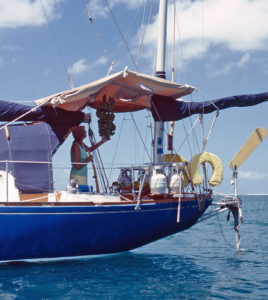Note: The following is taken in part from my memoir, Sailing with Impunity: Adventure in the South Pacific.
Impunity’s Aries wind vane proved to be one of our most valuable assets. As we prepared the boat for off-shore cruising, we even sent to England for spare parts for our wind vane, knowing how valuable it was to have self-steering capability. A wind vane is so valuable, it’s often thought of as an extra deck hand.
The wind vane, a thin plywood paddle that caught the wind’s direction, automatically adjusted the self-steering gear. Without it, all steering would need to be done by hand. Bruce kept an eye on the direction of the wind and tweaked the sails accordingly while the wind vane kept us on course. When the Aries steered the boat, the tiller was engaged to a chain hooked to the wind vane.
With favorable winds, hand-steering was rarely required. The wind vane did its job keeping us on course. Every once in awhile, it was necessary to make some adjustments, but for days on end we didn’t have to hand-steer or even change course.
Our easiest passage, a ten-day sail from Bora Bora to American Samoa, was blessedly uneventful. For awhile, we averaged 125 nautical miles a day; but settled into 100. Under these steady conditions ,the passage was so consistent that once Bruce adjusted the sails after an early rain squall, we sailed day-in, day-out with the same configuration. We never had to change sails or even adjust the wind-vane steering. It was the smoothest sail of the journey. The wind vane added immeasurably to our comfort and ease in sailing.
Months later, during one of our most difficult periods, a 30-day passage between American Samoa and Honolulu, we had some anxious moments with our wind vane. Around 3:00 a.m. while Bruce was on watch, he called to me, asleep below decks. He needed my help. Our steering vane had become partially detached from the boat. If Bruce couldn’t repair it, or worse, if we lost it altogether, it would mean having to hand-steer for the rest of the journey. Hand-steering makes a watch a real chore because you can’t leave the wheel or tiller without going off course.
Working upside down in the dark, his face inches from the rolling sea, Bruce hung over the transom to replace bolts while I shone a flashlight for him and held onto the seat of his pants to keep him from falling in. After about 20 minutes of fitting and tightening bolts, all the while upside down, he made the repair and reset the wind vane, and we were off again. Losing the vane wouldn’t have been life-threatening, but it would have been extremely inconvenient.
Again, we were thankful for our strict watch system. If no one had been on deck keeping watch and making routine checks on the equipment, the problem would likely have gone unnoticed until it was too late to save the vane. And, this was yet another affirmation of having spare parts on board for all the important systems on the boat, and also a reminder of the importance of a sailor knowing his boat intimately.
Our Aries wind vane was one of our most useful tools. It helped to make our journey a pleasurable success.



I never knew of wind vanes – let alone how they are used. At what point does a sail boat grow too large for this practical equipment and need electronic guidance systems? You and Bruce both sound like practical, strong, creative people. I would not know how to begin to plan such an undertaking.
When we sailed throughout the South Pacific GPS weren’t perfected enough for Bruce to trust them. Nowadays they are more reliable, but Bruce says he would still go with celestial navigation as his main system, electronics as his second. Electronics have a way of breaking down, which could be fatal.
I learned something new from this.
Thanks for your comment, Hema. I’m always amazed when I delve into something new and learn how much I don’t know!
I read this before in your memoirs. Very interesting. I’ve never so much as paddled a canoe, and am not sure if the sea would call to me as it did to you and Bruce, but I enjoy reading about your adventures.